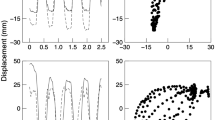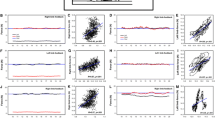Summary
When movements are performed together in the upper-limbs, a strong tendency emerges to synchronize the patterns of motor output. This is most apparent when trying to do different things at the same time. The present experiment explored the simultaneous organization and control of spatiotemporally different movements. There were two practice conditions: symmetrical and asymmetrical. In the symmetrical condition, subjects performed a series of unidirectional elbow flexion movements, followed by a series of elbow flexion-extension-flexion (reversal) movements in both limbs simultaneously. In the asymmetrical practice condition, subjects performed the unidirectional movement in the left limb together with the reversal movement in the right limb. Findings revealed a tendency for each limb movement to assimilate the features of its counterpart under the latter condition. This effect was “asymmetrical” in that the unidirectional movement was more attracted to the reversal movement than vice versa. Nevertheless, subjects were able to partly suppress this synchronization tendency as was evident from the moderate cross correlations between the angular acceleration patterns of both limb movements and from an increasingly successful differentiation of the activity levels in the right and left limb muscles. All together, these findings provide evidence for some degree of parallel control of spatiotemporally different actions. The data are discussed in view of the possible suppression of a bilaterally distributed motor control system, that is mainly held responsible for activiting proximal limb musculature.
Similar content being viewed by others
References
Asanuma H (1989) The motor cortex. Raven Press, New York
Baldissera F, Cavallari P, Civaschi P (1983) Preferential coupling between voluntary movements of ipsilateral limbs. Neurosci Lett 34:95–100
Basmajian JV (1963) Control and training of individual motor units. Science 141:440–441
Basmajian JV (1974) Muscles alive: their functions revealed by electromyography, 3edn. Williams and Wilkins, Baltimore
Basmajian JV (1977) Motor learning and control: a working hypothesis. Arch Phys Med Rehab 58:38–41
Brinkman J, Kuypers HGJM (1972) Splitbrain monkeys: cerebral control of ipsilateral and contralateral arm, hand, and finger movements. Science 176:536–538
Brinkman J, Kuypers HGJM (1973) Cerebral control of contralateral and ipsilateral arm, hand and finger movements in the split-brain rhesus monkey. Brain 96:653–674
Brinkman C, Porter R (1979) Supplementary motor area in the monkey: activity of neurons during performance of a learned motor task. J Neurophysiol 42:681–709
Chang HT, Ruch C, Ward AA (1947) Topographical representation of muscles in motor cortex of monkeys. J Neurophysiol 10:39–56
Chang P, Hammond GR (1987) Mutual interactions between speech and finger movements. J Motor Behav 19:265–274
Cohen L (1970) Interaction between limbs during bimanual voluntary activity. Brain 93:259–272
Cordo PJ, Nashner LM (1982) Properties of postural adjustments associated with rapid arm movements. J Neurophysiol 45:287–302
Di Stefano M, Morelli M, Marzi CA, Belucchi G (1980) Hemispheric control of unilateral and bilateral movements of proximal and distal parts of the arm as inferred from simple reaction time to lateralized light stimuli in man. Exp Brain Res 38:197–204
Easton TA (1972) On the normal use of reflexes. Am Scientist 60:591–599
Evarts EV (1981) Role of motor cortex in voluntary movements in primates. In: Brooks VB (ed) Handbook of physiology, Sect 1. The nervous system, Vol II. Motor control. American Physiological Society, Bethesda, pp 1083–1120
Gelfand IM, Gurfinkel VS, Tsetlin ML, Shik ML (1971) Some problems in the analysis of movements. In: Gelfand IM, Gurfinkel VS, Fomin SV, Tsetlin ML (eds) Models of the structural-functional organization of certain biological systems. MIT, Cambridge, pp 329–345
Ghez C (1979) Contributions of central programs to rapid limb movement in the cat. In: Asanuma H, Wilson VJ (eds) Integration in the nervous system. Isaku-Shoin, Tokyo, pp 305–319
Gunkel M (1962) Über relative Koordination bei willkürlichen menschlichen Gliederbewegungen. Pflügers Arch Ges Physiol 275:472–477
Holst E Von (1939) Die relative Koordination als Phänomen und als Methode zentralnervöser Funktionsanalyse. Erg Physiol 42:228–306
Holst E Von (1973) The behavioral physiology of animals and man: the collected papers of Erich Von Holst, Vol I (R Martin, Transl). Methuen, London
Jongen HAH, Denier Van Der Gon JJ, Gielen CCAM (1989) Inhomogeneous activation of motoneurone pools as revealed by co-contraction of antagonistic human arm muscles. Exp Brain Res 75:555–562
Keele SW (1981) Behavioral analysis of movement. In: Brooks VB (ed) Handbook of physiology, Sec 1, Vol II. Motor control, Part 2. American Physiological Society, Bethesda MD, pp 1391–1414
Keele SW (1986) Motor control. In: Kaufman L, Thomas J, Boff K (eds) Handbook of perception and performance. Wiley, New York, pp
Kelso JAS, Tuller B (1984) A dynamical basis for action systems. In: Gazzaniga MS (ed) Handbook of cognitive neuroscience. Plenum Press, New York, pp 321–356
Kelso JAS, Southard DL, Goodman D (1979) On the nature of human interlimb coordination. Science 203:1029–1031
Kelso JAS, Putnam CA, Goodman D (1979) On the space-time structure of human interlimb co-ordination. Q J Exp Psychol 35A:347–375
Kinsbourne M, Hiscock M (1983) Asymmetries of dual-task performance. In: Hellige JB (ed) Cerebral hemisphere asymmetry: method, theory, and application. Praeger, New York, pp 255–334
Kugler PN, Kelso JAS, Turvey MT (1980) On the concept of coordinative structures as dissipative structures. I. Theoretical lines of convergence. In: Stelmach GE, Requin J (eds) Tutorials in motor behavior. North-Holland, Amsterdam, pp 3–47
Kuypers HGJM (1973 The anatomical organization of the descending pathways and their contributions to motor control especially in primates. In: Desmedt JE (ed) New developments in electromyography and clinical neurophysiology, Vol III. Karger, Basel, pp 38–68
Kuypers HGJM (1985) The anatomical and functional organization of the motor system. In: Swash M, Kennard C (eds) Scientific basis of clinical neurology. Churchill Livingstone, Edinburgh, pp 3–18
Lestienne F (1979) Effects of inertial load and velocity on the braking process of voluntary limb movements. Exp Brain Res 35:407–418
Marteniuk RG, MacKenzie CL, Baba DM (1984) Bimanual movement control: information processing and interaction effects. Q J Exp Psychol 36A:335–365
Moore SP, Marteniuk RG (1986) Kinematic and electromyographic changes that occur as a function of learning a time-constrained aiming task. J Motor Behav 18:397–426
Pandya DN, Gold D, Berger T (1969) Interhemispheric connections of the precentral motor cortex in the rhesus monkey. Brain Res 15:594–596
Preilowski B (1975) Bilateral motor interaction: perceptual-motor performance of partial and complete “split-brain” patients. In: Zulich KS, Creutzfeldt O, Galbraith GC (eds) Cerebral localization. Springer, Berlin Heidelberg New York, pp 115–132
Schmidt RA (1988) Motor control and learning. Human Kinetics, Champaign IL
Schmidt RA, Sherwood DE, Walter CB (1988) Rapid movements with reversals in direction. I. The control of movement time. Exp Brain Res 69:344–354
Sherwood DE, Schmidt RA, Walter CB (1988) Rapid movements with reversals in direction. II. Control of movement amplitude and inertial load. Exp Brain Res 69:355–367
Swinnen SP (1990a) Motor control. In: Dulbecco R (ed) Encyclopedia of human biology. Academic Press, San Diego (in press)
Swinnen SP (1990b) On the human control system's capability to dissociate bimanual movements. In: Requin J, Stelmach GE (eds) Tutorials in motor neuroscience. Kluwer, Dordrecht (in press)
Swinnen SP, Walter CB (1988) Constraints in coordinating limb movements. In: Colley AM, Beech JR (eds) Cognition and action in skilled behaviour. Elsevier Science Publishers, Amsterdam, pp 127–143
Swinnen S, Walter CB, Shapiro DC (1988) The coordination of limb movements with different kinematic patterns. Brain Cogn 8:326–347
Swinnen SP, Walter CB, Beirinckx MB, Meugens PF (1990a) Dissociating the structural and metrical specifications of bimanual movement. J Motor Behav (in press)
Swinnen SP, Walter CB, Pauwels JM, Meugens PF, Beirinckx MB (1990b) The dissociation of interlimb constraints. Hum Perform 3:187–215
Walter CB (1984) Temporal quantification of electromyography with reference to motor control research. Hum Mov Sci 3:155–162
Walter CB, Swinnen SP (1990a) Asymmetric interlimb interference during the performance of a dynamic bimanual task. Brain Cogn 14:185–200
Walter CB, Swinnen SP (1990b) Kinetic attraction during bimanual coordination. J Motor Behav 22:451–473
Yamanishi J, Kawato M, Suzuki R (1979) Studies on human finger tapping neural networks by phase transition curves. Biol Cybern 33:199–208
Yamanishi J, Kawato M, Suzuki R (1980) Two coupled oscillators as a model for the coordinated finger tapping by both hands. Biol Cybern 37:219–225
Author information
Authors and Affiliations
Rights and permissions
About this article
Cite this article
Swinnen, S.P., Young, D.E., Walter, C.B. et al. Control of asymmetrical bimanual movements. Exp Brain Res 85, 163–173 (1991). https://doi.org/10.1007/BF00229998
Received:
Accepted:
Issue Date:
DOI: https://doi.org/10.1007/BF00229998




